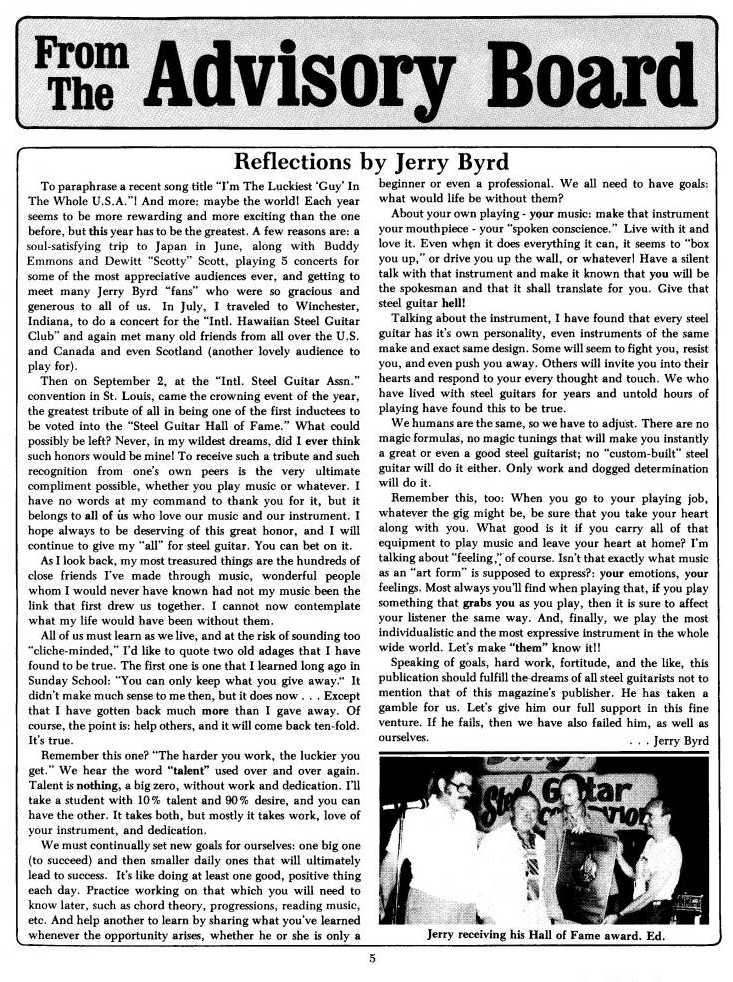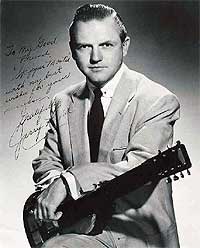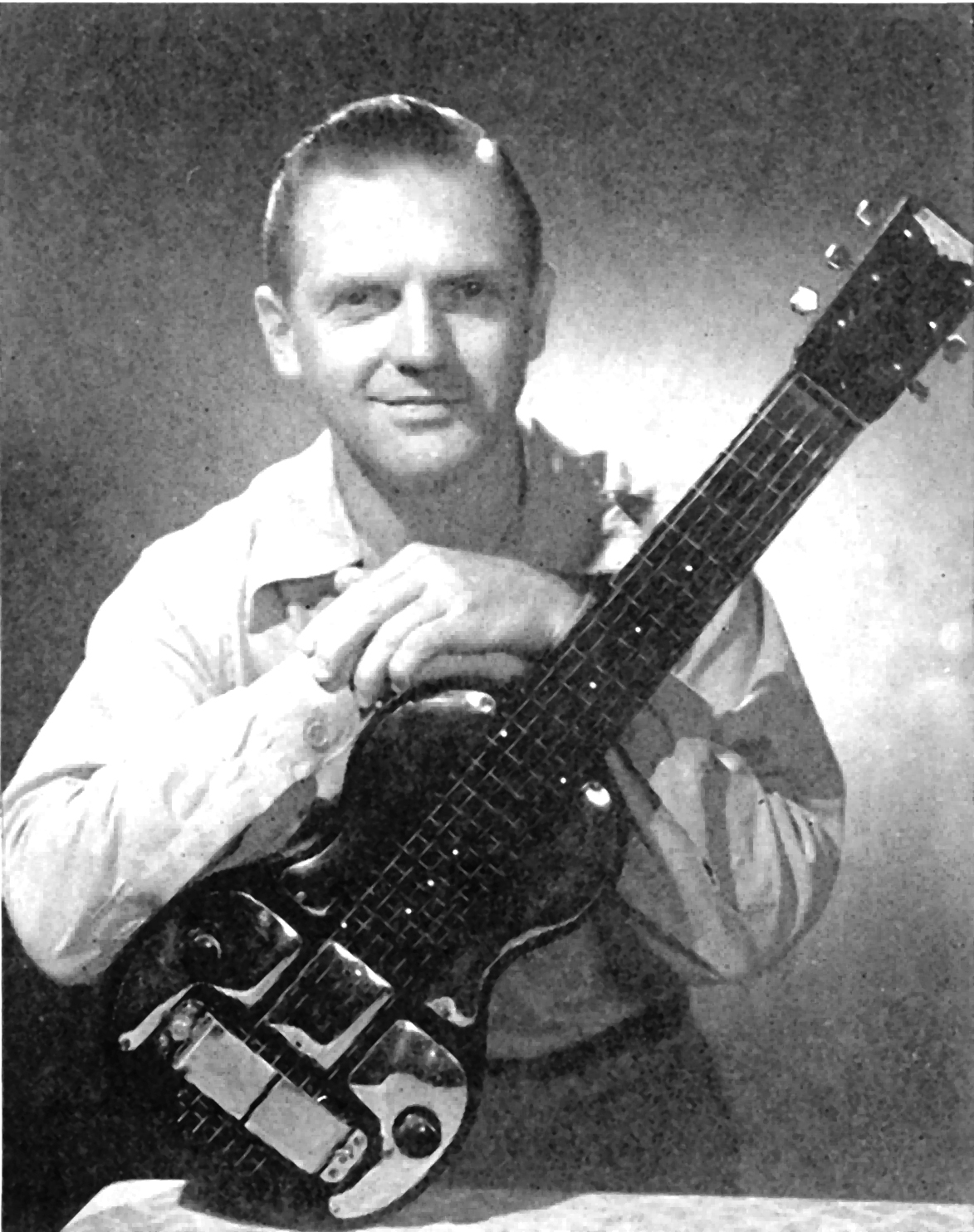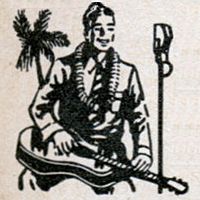Jerry Byrd Shares His Gear And Techniques
By Jerry Byrd (1920-2005)
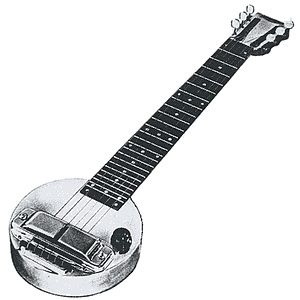
"The most indelible impression I want to leave with you is that the Hawaiian steel guitar must be played not only with the head and the hands, but also with the heart. As with any instrument, a musician plays with his head and hands, but an artist plays with head, hands, and heart. That is even more so with the steel guitar, one of the most versatile and expressive instruments in the world.
STEEL GUITARS. In choosing your equipment, my personal preference is a double neck guitar with eight strings on each neck, short scale. That means the distance from the bridge to the nut is 22.5 inches, as opposed to the long scale which is 24.5 inches. I prefer the short scale because it enables the player to make more accurate slants, especially at the lower frets. The most desirable distance between strings is three eighths of an inch.
PICKS. I use two metal finger picks, which can be bought in various gauges. I prefer a Dunlop medium #18. A metal pick can expand and become loose while playing. If the pick is not too hard, you will be able to squeeze it back to its proper shape. I bend the picking section back to fit the roundness of my finger tips. I prefer a plastic wrap-around thumb pick with a rather long picking tip.
STEEL BAR. The steel bar should be two and three - fourths inches long and three quarters of an inch in diameter, rounded at one end and recessed at the other end. The recessed end is for your thumb tip to fit into when controlling the bar in playing slant positions. If your bar is longer, you will have difficulty in slanting correctly.
AMPLIFIER. My personal preference in an
amplifier is the older-style tube amp. I use a Fender Twin. I keep the
volume set at about 4 on a scale of 1-10, the reverb at 4 as well. I like
the treble turned almost off and the bass nearly wide open. The final
adjustment in tone is done on the guitar itself, keeping the volume wide
open on the guitar.
TUNING. To tune your guitar, it is best to develop your ear rather than to
depend on an electronic tuner. A tuner is a valuable tool if you must
re-tune while other music is being played, but it's best to develop your
musicianship in every possible way. Unless you have the gift of perfect
pitch, you must tune your first string to another instrument that you know
to be in tune Tune your second sting to your first string by intonation. By
that, I mean learn to recognize the interval you desire. If you are tuning
to A major, your first string is E, your second string C#. The interval
between is a minor third. Pluck the two strings at the same time and keep
changing the second string until you hear a minor third. The third string
will be an A. Tune it to the second string, C#. The interval separating them
is a major third. The sound of the three strings, E.C#.A, is a major triad.
Learn to recognize it. Your three bass strings are octaves of the first
three strings. Tune each bass string to its octave string. Listen for a
'fluttering' sound. When it's gone, your two strings should be in tune, an
octave apart.
STEEL BAR MANIPULATION. To hold the bar correctly, turn your left hand palm up. Place the bar on the line between the first two fingers with your thumb on the last half inch of the bar. Turn your hand over and place the bar on the strings. Your thumb stays well back, controlling only the last half inch of the bar. Your first finger should be arched so that the tip of the finger acts as a pivot during slanting and exerts a gentle downward pressure to eliminate string vibration sounds. Your second finger lies on the strings behind the bar, keeping the bar straight Your hand is anchored to the strings by the last two fingers.
"Your right hand must have the wrist slightly to the left, so that the right edge of your palm is parallel to the frets. (This position helps you to play palm harmonics.) Your thumb and fingers will not be in a straight line, but rather the thumb extends farthest to the left, the first finger a little bit to the right of it, and the second finger farther right again. Your thumb mostly picks forward (away from you) and your two fingers pick backward (toward you, in a hand-closing action). When all three pick at the same time, it's the same action as when closing the lid of a bottle.
"All of your playing style is developed with your hands. When picking a single string passage, use your thumb pick. When double-stopping (picking two strings at a time) use thumb and first finger or thumb and second finger. If the two strings are inside strings (strings lower than the first string) use the thumb and first finger. When triple-stopping, use the thumb and both fingers. Arpeggios or strums are played with the thumb.
MUTING. Muting is a technique of the palm of your right hand. It is used when the sounding of a certain string is no longer wanted. For example, if the player strikes the first and second string, then wants to move to a position in which the first and third string will be played, the sounding of the second string must be eliminated. It is done by rapidly and imperceptibly damping all strings with the right edge of the right palm just before the second notes (the first and third strings) are plucked. If you are playing a fast passage of single string notes, changing from sting to string, you must dampen the sound of each string just as (slightly before) the following note is sounded.
DAMPING. For a novel effect, you can play a series of staccato notes in such a way that the tone is heard but the vibration is immediately cut off to make almost a popping sound. Very lightly lay the edge of the palm of your right hand on the strings as close to the bridge as you can get, and pluck the strings with your thumb. Use normal bar movement.
VIBRATO. The vibrato of your left hand is the greatest single factor that makes your playing unique. Just as we recognize your voice on the telephone, your playing style is recognizable by your vibrato. Be natural, do not make your bar travel too far an either side of the fret. Avoid the 'nanny- goat' sound of vibrating too quickly. The vibrato on the higher frets must be more shallow but the frequency should remain the same. Think of it as using an eraser to rub out a spot. Your wrist doesnít bend, the action is rather with the first two fingers and thumb on the bar, anchored by the last two fingers on the strings.
FORWARD SLANT. Begin by pushing the bar back (to the left) with your thumb so that your thumb is almost at the end of the bar and you can see clearly where the bar contacts the strings, thereby staying on pitch. At the same time, push the bar away from yourself so that your fingers go over the edge of the first string. This movement keeps the rounded end of your bar from dropping between the first two strings. The tip of your first finger (which is arched) keeps the bar positioned correctly on the top string of the slant. To go back to straight-bar position, pull your arm back toward yourself and the bar will naturally straighten.
REVERSE SLANT. For a reverse slant, the thumb goes to the recessed end of the bar where it has good control, and pushes forward (to the right). The first finger, acting as a pivot, keeps the tip of the bar from losing or gaining pitch. Again, push the tip of the bar outward at the same time so it doesn't slip down between strings.
SPLIT STRING SLANT. This is done by permitting the tip of your bar, the rounded nose, to rest between the top two strings, thereby making contact on either side of the bar at any given fret, and placing the bar on a forward slant so that the third or fourth string can be played one fret lower. Example: Top two strings at fret 4, third or fourth string at fret 3. This makes the playing of more chords possible, and of course it can be done not only on the top two strings but on any two adjacent strings, slanted to one fret lower on a selected string below them. This technique was used in tablature arrangements by Alex Hoapili and Andy Iona for the Oahu Publishing Co., 1939.
HARMONICS. These are musical ornamentation of the most delicate kind. There are many ways to do them, but all harmonics have this in common: the picking of the string and the stopping of the fret (with the finger, palm, or knuckle) must be perfectly synchronized. Just as the pick flies off the string immediately after picking, so must the finger, palm, or knuckle fly off the string immediately after picking in order to produce a harmonic. If it is left on too long, a muted 'flubbing' sound will be heard. If it is removed too soon, an ordinary note will be heard instead of a harmonic.
Finger Harmonics. These have also been called 'natural' and 'open string' harmonics. They are usually played at the 5th, 7th, and 12th frets. They are so-called because the bar is not used at all. Instead, the little finger of the left hand acts as a bar and touches very quickly on the strings at the 5th, 7th, or 12th fret The right hand plucks the string at the same time. Best results are achieved by moving the right hand as far to the right as possible, allowing for a longer string vibration length. Harmonics on the 12th and 5th frets produce the harmonic notes of the 12th fret, except that those on the 5th fret will be an octave higher. Harmonics an the 7th fret (also 19th fret) will be the harmonic notes of the 7th fret Those on the 19th fret will be the same as at the 7th fret, not an octave higher as you would expect.
Palm Harmonics. These are a much neglected but very important aspect of steel guitar playing. They provide a change of mood, are very secretive. Don't fight them, donít fear them, just relax and play them easily. Just as we have a nervous tendency to play the next note too soon rather than get the most value from the note we have just played, we're in the habit of tensing up and dreading the palm harmonics. Palm harmonics can be played at any fret, as long as the right edge of your right palm is held parallel to the frets, exactly 12 frets up from the steel bar. The trick is to pluck the string (with your thumb pick) at exactly the same instant as the palm is placed on the string, and to release the palm quickly enough to allow the harmonic to ring out. If you're quick with the thumb, you can strike several strings at once and produce a harmonic strum If you're very selective with your right palm, you can pluck two strings with your thumb pick, one of which is a harmonic and the other a natural note. You can also use thumb and finger pick to play strings that are not adjacent, or to play harmonics on a slant. Keep the steel bar right on the fret, do not use vibrato.
Finger Tip Harmonics. A variation of the palm harmonic can be produced by using the tip of the third finger, right hand, to touch the string exactly 12 frets (one octave) higher than the fret where the bar is placed. Your thumb pick will pick the string behind (to the right of) the third finger. With these harmonics you can be very selective of string and precise in finger placement as you can see exactly where the finger touches. If you are careful, a sequence of harmonics can be sounded and left zinging while new ones are being made.
Knuckle Harmonics. In the same way, you can use the knuckle of your little finger, right hand, to deaden the string and release. With your thumb, you pick the string to the left of the knuckle. These harmonics are the easiest when played with the knuckle 12 frets above the barred fret, but they (and finger tip harmonics) can be used at many other frets to produce higher harmonics, for very special effects. Very few musicians can do this: place your bar at the first fret. Do a harmonic with your finger or your knuckle at the 8th fret, first string. Assuming that the string is tuned to E, the harmonic note you produce will be a high C. Do it at the 6th fret to produce a high F harmonic, at the 5th fret for a high A, and at the 4th fret for a C one octave higher than the C you produced at the 8th fret. With these four notes, you can play 'Taps'. Place your bar at any fret you wish, just remember that these harmonics can be produced by placing the finger or knuckle 7 frets, 5, 4, and 3 frets higher than the bar. That's the secret of the harmonics used in playing 'Whispering Reef'.
"For both palm and knuckle harmonics, some players don't think of placing the hand (palm) 12 frets higher than the bar. Since they can't see exactly where the hand is touching the strings (thumb gets in the way) they prefer to note where their thumb pick was located at the time.
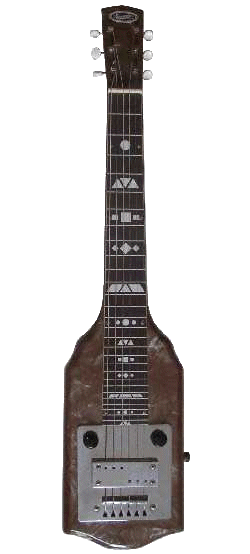 THE 'P'TAH' SOUND. To keep continuity of
sound when changing from one string to another, I like to achieve what I
think of as a thread woven in and out of a tapestry, keeping the sound
unbroken. I call it the p'tah sound. To move from one string to n adjacent
string, let's say for example from the second string on the 5th fret to the
first string on the 7th fret, pluck the note at the fifth fret and begin
moving your bar up the string toward the seventh fret. Keeping the bar
raised so that only the rounded tip is in contact with the strings, about
half way along the movement (near the 6th fret), move the bar tip over to
the first string. Pluck it and continue the glide up to the target, the 7th
fret. You will have plucked the second note a little early, but your p'tah
will sound like an unbroken thread of music. The technique is a bit
different, though, when moving between strings that are not adjacent. For
example, try moving between the same two frets (the 5th and 7th) but coming
from the fourth string to the first string. When the two strings were
adjacent you used the tip of the bar. When they are not adjacent you begin
by placing the bar flat across the strings. You pluck the first note, on the
fourth string, move the bar forward and raise it so that by the time you
reach the sixth fret you have only the tip on the first string. Pluck at the
sixth fret and continue the glide to the target, the 7th fret.
THE 'P'TAH' SOUND. To keep continuity of
sound when changing from one string to another, I like to achieve what I
think of as a thread woven in and out of a tapestry, keeping the sound
unbroken. I call it the p'tah sound. To move from one string to n adjacent
string, let's say for example from the second string on the 5th fret to the
first string on the 7th fret, pluck the note at the fifth fret and begin
moving your bar up the string toward the seventh fret. Keeping the bar
raised so that only the rounded tip is in contact with the strings, about
half way along the movement (near the 6th fret), move the bar tip over to
the first string. Pluck it and continue the glide up to the target, the 7th
fret. You will have plucked the second note a little early, but your p'tah
will sound like an unbroken thread of music. The technique is a bit
different, though, when moving between strings that are not adjacent. For
example, try moving between the same two frets (the 5th and 7th) but coming
from the fourth string to the first string. When the two strings were
adjacent you used the tip of the bar. When they are not adjacent you begin
by placing the bar flat across the strings. You pluck the first note, on the
fourth string, move the bar forward and raise it so that by the time you
reach the sixth fret you have only the tip on the first string. Pluck at the
sixth fret and continue the glide to the target, the 7th fret.
"For a fluid sound, where possible it's best to keep playing on the same strings by moving the bar up and down the frets, rather than to favor one or two frets and jump from string to string. This is true except where you feel the 'p'tah' effect is desirable.
STYLE AND EXPRESSION. The style you develop comes from what you do between the notes. Do you move directly from one to another? When the same passage is repeated, do you think of a more interesting way to make that same move? How do you handle your vibrato? Changes in volume? Know your tuning very well, know where all the chords are both on the fret board and in the song. Don't play just what's on the paper, put something of yourself in besides. Even in a fast tempo song, make it sound slow so your listener can relax. Music is an art form You must communicate with your listener. Most players over-play. They leave their heart at home and throw in every lick, every turnaround, every trick they know into every song they play. Don't do that Play it simply and from the heart. You want your audience to leave feeling enriched by your music. Listen to yourself when you play. Are you saying something, or just playing notes? Donít compete with other players, be sincere. The Hawaiian steel guitar is the most versatile and expressive instrument I know of. It deserves your best"
